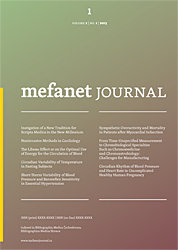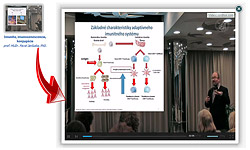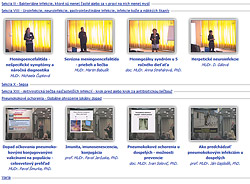
MEFANET Journal 2013; 1(1): 19–22
ORIGINAL ARTICLE
Video gallery of educational lectures integrated in faculty's portal
Jaroslav Majerník1,*, Pavol Jarčuška2
1 Department of Medical Informatics, Faculty of Medicine, Pavol Jozef Šafárik University in Košice, Slovakia
2 Department of Infectology and Travel Medicine, Faculty of Medicine, Pavol Jozef Šafárik University in Košice, Slovakia
* Corresponding author: jaroslav.majernik@upjs.sk
Abstract
Article history:
Received 4 April 2013
Revised 6 May 2013
Accepted 7 May 2013
Available online 9 May 2013
Peer review:
Ivo Říha, Martin Komenda
 Download PDF
Download PDF
This paper presents a web based educational video-clips exhibition created to share various archived lectures for medical students, health care professionals as well as for general public. The presentation of closely related topics was developed as video gallery and it is based solely on free or open source tools to be available for wide academic and/or non-commercial use. Even if the educational video records can be embedded in any websites, we preferred to use our faculty’s portal, which should be a central point to offer various multimedia educational materials. The system was integrated and tested to offer open access to infectology lectures that were captured and archived from live-streamed sessions and from videoconferences.
Keywords
video technology, distance education, video archive
Introduction
Plenty of teaching methods can be used to bring information and new knowledge from almost any scientific areas to the educational processes [1–3]. Similarly, health related information can be conveyed to the students, health professionals, but also to the patients with the aim to increase public knowledge and to ensure greater prevention behaviors [4–6]. The most frequently used methods include written materials, community programs, school programs, physician recommendations etc. However, these methods require various resources to be implemented and have usually limited coverage considering their widespread use in the general public [7, 8]. On the other hand, recent trends in education indicate an expansion of distance forms that can be considered as an effective alternative. Regarding used grade of technology, it may be organized as different concepts including distance learning, distributed learning, online learning, e-learning, virtual education, web-based learning, computer-based training, and blended or hybrid learning [9–11]. Therefore, the goal of our project is to use potential of such modern multimedia techniques to disseminate the latest infectology knowledge. In our project, we organize live video broadcasts of scientific and educational sessions and then the archived video lectures are shared in the form of online video-clips to be accessible anytime and anywhere.
Methods
To support distance education forms at our faculty we created a systematic approach in organization of special live streamed meetings. The selected specific topics cover the branch of infectology as it concerns not only clinicians and medical students, but also a large group of patients as well as a wide range of healthy population. In this way, we offer the most recent information and knowledge in periodically repeated sessions led by specialists from academic and health branches. Here, the topics like bacterial resistance against antibiotics, the most convenient anti-infectious treatment or nosocomial infections are only some of themes that every one of us should have information about. These topics specify also one of the major problems of European Commission (EC) in the area of public health. It is also the priority of national government as the consumption of antibiotics is one of the greatest in European Union (EU). European Surrveillance Antibiotic Consumption (ESAC) rated Slovak republic on the sixth place in consumption of antibiotics. Furthermore, there are 80 million patients hospitalized per year in EU and 5 percent of them get nosocomial infections. Approximately 40 thousand of such patients die of it. This is the reason why also the EC emphasizes the need to increase awareness of population using educational activities with the aim to improve situation and to solve these problems.
Individual live video streams are broadcasted as free to join events, so everybody interested in particular topics is able to watch them. However, there are often various objective reasons why some of the sessions cannot be viewed when broadcasted. Therefore, the raw video records are used to prepare archive of audiovisual lectures including DVD movies, compressed video formats for web as well as interactive presentations. Educational outputs are processed to be available for students in both on-line and off-line forms. In this manner, the streams can be archived and shared together with additional education materials. The process to create usable audiovisual educational works include scene capturing, editing and rendering of teaching suitable parts, adding additional content and comments, conversion to the requested video/multimedia format and publication of final materials as shown in Figure 1.
Here, considering the technical point of view, the selection of the most convenient video format was one of the most important parts for us. There are two preferred video formats to share video content on the web. These are MP4 and FLV, and both containers have their pros and cons. Because the flash was the most relevant target platform for many years, and because it uses progressive download, can be downloaded from start to finish over HTTP, plays as the file is downloaded (no need to wait), is low cost and effective and is useable also for slow connections, we selected the FLV. It also allows us to set good quality to file size ratio. Parameters like video size, bitrate, frame rate, aspect ratio and audio compression were set to acquire optimal output quality. We recognized the values like 640 × 480 px, 512 bps, 15 fps and MP3 audio are sufficient for our video lectures. It is because of combination of the dynamic movie of the speaker and the static frames of his/her presentation.
Results
Creation of educational videos was only the first part of our work. Then, we tried to find the best way to offer them to the public. As we want to move all electronic materials or at least the hyperlinks to such faculty materials on one place - faculty’s portal, the major question was how to share these movies in an attractive way? The answer was found in video galleries. To do this, we used principles of Video LightBox which is the free wizard program allowing adding videos to almost any website with stylish popup video effects. This beautiful product helps to generate source codes to embed particular video to the website in a few clicks. In general, it is necessary just to add video, to specify the template for video popup and video thumbnail appearance and to publish the result. Except of thumbnail, each educational video is equipped with the title and the name of the speaker/author. An example of resulting published lecture and FLV player embedded in our portal article is shown in Figure 2.
All the FLV files can be stored on external servers or directly on the portal. We did not specify any restrictions to access individual lectures as these should be available for all. However, respecting principles of the portal, the access rights can be specified in the same way as in other attachments. Then the content can be set to be available for various groups of users, including
- nonregistered anonymous users
- registered anonymous users who accept the terms of use within his/her registration
- users of MEFANET network, i.e., students or teachers from any Czech or Slovak medical faculty
- users of local university or faculty, whose affiliation to that university/faculty has been verified at the portal via the local information system of that university/faculty
- users to whom attachments are made available only on the author’s explicit consent
In order to have a clear and well-arranged list of video lectures, we separated closely related themes in 15 groups. These groups were classified as sessions to cover most relevant infectology topics including the most frequent bacterial infections, antibacterial pharmaceutics, respiratory infections, nosocomial infections, resistance on anti-infective pharmaceutics, preventions against infections, antivirotic treatment of the most frequent infections, etc.
Currently, there are lectures in six of these 15 sessions published on the portal. All the sessions are presented as simple hyperlinks and their content is shown or hidden only after the user will select it. In this way, it is possible to filter the video lectures, save the space in the article and to show the users only the materials he/she is interested in. An example of final published video gallery is shown in Figure 3.
Discussion
Learning science is quite complicated system affected by too many input and output factors that should be beard in mind while searching for optimal and the most effective methods. We suppose the combination of traditional teaching methods and new technological innovations satisfies teachers as well as students and may offer optimal learning experience also for clinical medicine subjects. Therefore, we capture the live broadcasted lectures and the records are processed to be used by the students during their study, but also by the wider group of undergraduate students, PhD students, physicians in continuous education and general public. Such audiovisual content is shared using our faculty’s portal with no restrictions that ensures whole world accessibility.
Acknowledgements
Results presented in this work were obtained with the support of the national grants KEGA 005UPJS-4/2012 (70%) and KEGA 004UK-4/2011 (30%).
References
[1] Gorghiu G, Gorghiu LM, Bizoi M, Suduc AM. Setting up of a web educational video-clips exhibition related to the implementation of virtual experiments in Sciences education. Procedia Soc Behav Sci 2010; 2(2): 2906–2910.
[2] Masats D, Dooly M. Rethinking the use of video in teacher education: A holistic approach. Teach Teach Educ 2011; 27(7): 1151–1162.
[3] Wiens PD, Hessberg K, LoCasale-Crouch J, DeCoster J. Using a standardized video-based assessment in a university teacher education program to examine preservice teachers knowledge related to effective teaching. Teach Teach Educ 2013; 33: 24–33.
[4] Goodman K, Nowacki A, Wua J, Hickner J. Utilization and impact of pre-office visit video health maintenance education. Patient Educ Couns 2011; 85(2): e65–e68.
[5] Komenda M, Schwarz D, Feberova J, Stipek S, Mihal V, Dusek L. Medical faculties educational network: Multidimensional quality assessment. Comput Meth Programs Biomed 2012; 108(3): 900–909.
[6] Penhaker M, Krawiec J, Krejcar O, Novak V, Bridzik R. Web System for Electrophysiological Data Management 2010. In:2nd International Conference on Computer Engineering and Applications 2010: 404–407. ISBN 978-0-7695-3982-9.
[7] Ramsay SA, Holyoke L, Branen LJ, Fletcher J. Six Characteristics of Nutrition Education Videos That Support Learning and Motivation to Learn. J Nutr Educ Behav 2012; 44(6): 614–617.
[8] Kozlikova K, Martinka J, Bulas J. ST segment body surface isointegral maps in patients with arterial hypertension. Physiol Res 2012; 61(1): 35–42.
[9] Reisslein J, Seeling P, Reisslein M. Video in distance education: ITFS vs. web-streaming – evaluation of student attitudes. Internet Higher Educ 2005; 8(1): 25–44.
[10] Macurova A. The roughness surface expressed by the mathematical model. Appl Surf Sci 2010; 256(18): 5656–5658.
[11] Kay R, Kletskin I. Evaluating the use of problem-based video podcasts to teach mathematics in higher education. Comput Educ 2012; 59(2): 619–627.
Please cite as:
Majerník J, Jarčuška P. Video gallery of educational lectures integrated in faculty's portal. MEFANET Journal 2013; 1(1): 19–22. Available at WWW: http://mj.mefanet.cz/mj-01130404.
This is an open-access article distributed under the terms of the Creative Commons Attribution-NonCommercial-ShareAlike 3.0 License (http://creativecommons.org/licenses/by-nc-sa/3.0/), which permits unrestricted use, distribution, and reproduction in any medium, provided the original work, first published in the MEFANET Journal, is properly cited. The complete bibliographic information, a link to the original publication on http://www.mj.mefanet.cz/, as well as this copyright and license information must be included.













